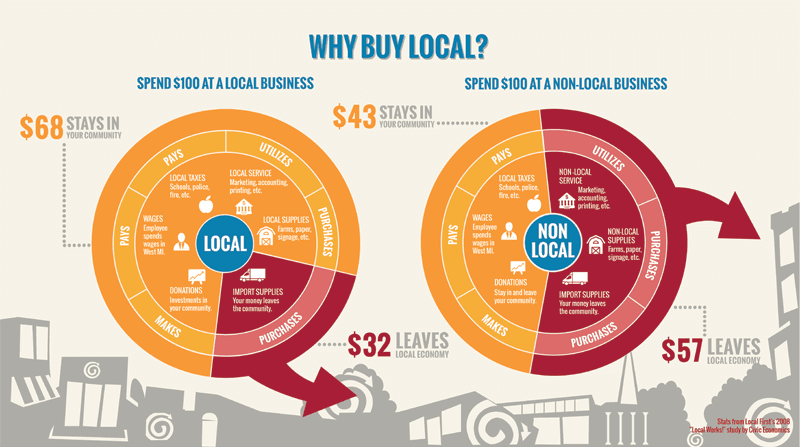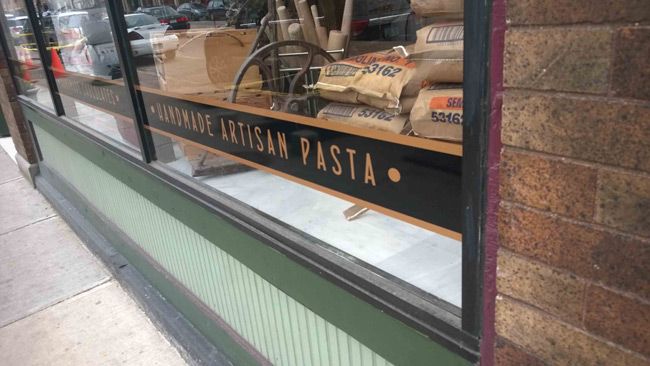Localism has become a buzz word in Grand Rapids. It’s everywhere—from the signs outside of “farm-to-table” restaurants to the pages of tourism brochures advertising “Beer City USA.” It’s a term that has an ambiguous meaning, which is one of its strengths and weaknesses. The veil of “localism” encompasses many different economic activities, from farmer’s markets and coffee shops to design companies and even small manufacturing enterprises. For its advocates, it’s held up as an undeniable “good.” For those who aren’t convinced, a fairly well-known study is often quoted as proof of its “goodness”.
This sense of goodness is central to much of the local hype. On a prominent website advocating for locally-centered economies, this appeal to equality is made rather explicit: “…we’re all better off, when we’re all better off.” It’s a clear progressive gloss on what is essentially just a new trend within capitalism.
The ambiguous feel-good concept of localism is used to cover up not just real economic disparities, but to deflect against any criticism. A new development cannot be criticized because it’s a locally-operated green building run by a non-profit, a restaurant serving locally-grown food isn’t perpetuating gentrification because it’s not a corporate chain, and a handmade-goods boutique store isn’t gentrifying a neighborhood because its owners see it as somehow “making a difference”. Localism is about putting a friendly face on capitalism and hiding the inequalities within it. Similarly, localism also brings a Do-It-Yourself (DIY) ethic or culture into the market economy.
The following sets out to explore some of the concepts of localism and provide some preliminary thoughts on how it functions in Grand Rapids. This is not meant to be an exhaustive critique and there are no doubt many points that may have been missed. As should be obvious, we’re also not making an argument against localism in favor of some kind of globalized economy, either. There’s nothing wrong with buying local kale per se, as long as it isn’t done under the guise of it being an act of liberation. We’re making space to challenge the sacred concept of localism, which is often immune from criticism.

I. Declaw-It-Together
DIY (“Do It Yourself”), having its origins in punk subcultures, carries on the tradition of creating or repairing things with limited resources and means. Dumpster diving, bike repair, vegetable gardening, and sewing are some examples of DIY activities. There is an emphasis on collective learning outside and in opposition to hierarchies of expertise, with skills shared horizontally throughout the DIY community and an emphasis on active participation. Though the projects may have specific intentions and goals, the means of making and repairing is not only logical to many, but within this subcultural context, is an outright rejection of consumer culture and profit. Contrast DIY in this context with the ever-growing maker-culture and we see a DIY aesthetic (ie. Upcycled, hand-dyed, etc…) dressed up and sold to anyone with the desire to buy it. Even within the DIY subculture, some have heralded a shift towards a “DIT” (“Do It Together”) attitude. In most cases, the DIT approach is more professionalized and less rebellious. As part of this DIY as been commodified and reduced to an aesthetic that coincides and exists within the market rather than in opposition to it. The appearance of organic and handmade items appeals to a particular type of consumer, one which is growing at a rapid pace. Purchasing a “DIY product” gives one the ability to “participate” without actually having to physically do so, with DIY thereby becoming one of any number of purchasable identities that exist in the capitalist market.
II. Adventures in Gentrifying
The “local” hype has an undeniable tie to gentrification. This is especially true in Grand Rapids, but is largely a universal phenomenon. What we celebrate as great examples of “local” businesses are usually of a particular type. We’re not talking about the BBQ place on the southeast side, the auto mechanic that your family swears by on Plainfield, or the family-owned hardware store on the westside. Instead, it’s the farm-to-table pizza place, the wine bar, the brewery, the gastro pub, the pour-over coffee shop, the artisan pasta store, ad nauseam (nausea is more like it!). These businesses share a common clientèle: people who tend to have more money and who want to experience “the adventure” of the urban environment. As such, they are willing to spend more money on things other folks buy for significantly less (for example, artisan ramen noodles). They understand that consumption brings status. There is a built-in class association.
Similarly, localism can serve as a smokescreen to distract people from what is actually happening. Because “local” is invoked as an ethical system, it is assumed nothing is wrong. The “local” business is somehow immune from the charge of gentrification because it showcases “local” products—nevermind that many of these celebrated businesses are located in areas that are (or have undergone) significant gentrification. In other cases, to borrow the concepts of gentrification scholar Neil Smith, these businesses serve as initial “outposts” on the untamed “urban frontier”—the colonial language is no accident—and serve as the testing ground before they are transformed into bourgeois enclaves. The Downtown Market on the far southern edge of downtown Grand Rapids comes immediately to mind, but numerous other examples exist along Wealthy Street or Bridge Street.

III. Carbon Copy Creatives
Triangles/geometric shapes, pastels, shades of white, black/white, vintage, simple, gold jewelery, white typography (helvetica/times new roman/handwritten fonts), outlandish (fake) glasses, mustaches, beards, bangs, minimal design, pictures of brunch, leggings, simplistic tattoos, thin, white people, woodgrain anything, twine, tweed, culturally appropriative patterns, chalkboard signs, pour-over coffee, artisan doughnuts, small business, arrows, general store, butcher shops, lavender flavor, goatmilk soap, tacos, food truck, microgreens, artisan ramen, craft beverages, brewed things, small succulent plants, air plants, paint-dipped anything, antlers… and the list goes on. High-quality & hand-crafted small unimportant things like salt and pepper shakers are markers of wealth (or debt). Peddlers of these images and things, either socially or commercially, often parrot attitudes and phrases of “making a difference” in this world of mass-produced goods. Sure they can’t compete with sweatshop labor or multinational corporations, but they’re not aiming to anyway. The fact is, these niche economies market to pretty much only each other and those from a distance who are willing to pay. The maker and the consumer are interchangeable, often trading places behind the cash register (Apple device) in this consumer “scene”. And scene is what it is. Stealing the rag-tag DIY aesthetic hoping to resemble something genuine and gritty, while mimicking what wasn’t theirs to begin with (unless one has completely sold out), these folks have got it down to a handwritten T. So much so, that we’re convinced they’ve bought the proverbial ethically-caught salmon themselves – hook, line, and sinker.
IV. Guilt-Free Consumption
Your local, ethical economy is a fantasy, because your local, ethical economy only exists for a certain subset of people. It’s the same economy that runs on dirty factories, sweatshops, and chain stores, it’s just that you’ve cordoned yourself into the block of the marketplace that’s curated to appeal to your ethics and aesthetics.
The dish you just ordered is made of plants grown organically just a few miles away, but there’s still someone cleaning your shitstains out of the bathroom, someone emptying the dumpster in the alley behind the restaurant, and someone cleaning the curb out front so you can feel safe parking your bike there.
The coffee they’re serving comes in a locally designed package from a local company, though now that you think about it, you’re not sure where the nearest coffee bean farm is. Apparently a farmer in Nicaragua got a fair trade for it. But someone else loaded it onto a ship, someone else pumped the ship full of fuel, someone else piloted the ship across an ocean, someone else unloaded it onto a truck, someone else roasted it, and now someone else is smiling courteously while they pour it for you. Did they get a fair trade or a fair wage too? What’s fair, even?
The scarf you’re wearing was made by the hands of someone you know by name – maybe you even know the name of the sheep who gave its wool for it! The laptop the maker needs to maintain their website and the smartphone you’re using to scroll through their Instagram were made by hands too, in a way – someone’s hands helped assemble them in the factory, and before that, someone’s hands – likely a child’s hands – sifted through a poisonous mine to find the rare minerals needed to make the screen light up with the image of the beautiful, guilt-free scarf.
The maker buys and sells, the shopper buys and sells, the product changes hands and magically assumes value. Same dance, similar choreography, better vibes. In this dance, nothing ethical can exist without the assistance of something you’d shiver at.

V. The Butcher, The Baker, The Candlestick Maker
Localism is oriented around the production and acquisition of high-end goods and services. In fact, it has to be. In a globalized economy, it is the only way that a local business can compete. The artisan noodle shop isn’t going to be able to produce enough noodles to compete with Barilla, instead it must distinguish itself by offering items of an (allegedly) exceptional quality. The same is true of the leather shop selling a fantasy of the cobbler-based shoe production of 150 years ago. Even when the quality isn’t superior, the status one obtains is unmistakable.
Enter the niche market, which localism is built around. After decades of mass production and consumption, diversified consumer options are necessary to keep people consuming. We buy products to construct our identities and difference. Local businesses cater to this. “Sustainable,” “local,” and “natural” are just selling points necessary for distinguishing a product in a globalized world. Local businesses pride themselves on exceptional customer service, but that’s just another way they mirror the actions of their larger counterparts in capitalism. Customer service is at best a way for a business to distinguish itself in the capitalist marketplace, at worst, it’s a means of commodifying everything. Local businesses are experts at selling an aesthetic and their workers themselves often become commodified: the surly tattooed waiter or the coffee shop worker conforming to stereotypical norms of hipster “beauty” are necessary in constructing the mystique of the local. A worker’s labor is no longer the only thing sold, it is now their identity which often imparts a certain type of cachet onto a business. At the same time, the new localist businesses sell aspects of social life—attention, hospitality, empathy, assistance, and interaction—that were once a part of everyday life. After artificially constructing a new urban landscape, capitalists must in turn sell us an artificially functioning community to hide the structural and implicit violence on which it is ultimately built.
VI. Commodifying Life
Price tags don’t just live in store windows, they rain down into every aspect of our lives. We’re all walking around with dollar signs in our eyes, because that’s how we’ve been taught to see. We’re taught we can buy wellness from the pharmacy, status from the car dealership, security from the loan office, that our very bodies are property or objects with varying levels of worth depending on what color they are and which parts they came with. But none of this is new.
It’s not novel that a local/handmade/artisan item would get a price tag, because the same item would have had a price tag had it been mass-produced, and the labor it took to make would have been compensated had it been performed in a factory. What’s novel is that the very act of making has been commodified. How strange that an act as basic and intimate as lovingly making something by hand is an increasingly legitimate and celebrated avenue for profit. How strange that when let down by bosses, customers and products, we turn ourselves into bosses, our friends into customers, and our skills into products.
VII. That Which Does Not Kill It…
By its integration into the economy, DIY has become part of “the problem.” Endless wars, environmental disasters, police murders, and mass starvation in addition to widespread anxiety, depression, stress, and existential crisis are all products of a world shaped by capitalism. But capitalism isn’t just a vague abstraction hovering above us, it is the daily actions of everybody who is subject to its touch. By working, shopping, putting money in the bank, and through thousands of subtle “normal” acts we are contributing to the growth of capital. There is no escape, but there are attempts at subversion. DIY was once seen as the latter, being a way to undermine corporate profits by choosing instead to produce ones’ own means to live. Now that it lacks this ethic it is no more or less responsible for the horrors of daily life produced by capitalism than the average corporation or small business. Just like every other person entangled in capitalism’s web, they both share responsibility for and are victims of the system’s horrors in one way or another. Like any other monetary transaction, when money is spent at one of these establishments it ends up tangled up in the recesses of finance and investment, fueling bank loans and growing business investments. Meanwhile, the economy grows and colonizes more aspects of life. It’s not that participation in the economy sustains the economy, but rather that the participation IS the economy itself.

VIII. Clocking Out is so Passé
Localism in the form of handmade artisan goods is a result of the entrepreneurial turn of DIY, which decayed in the last decade from counter-culture to commodity. Significant in this sequence of events is the Great Recession beginning in 2008, which plunged millions into unemployment and millions more into jobs working far less than they needed to get by. With this surplus of desperate people came the rise of Etsy, a marketplace for buyers and sellers of handmade and antique items, as well as a number of similar websites that provide platforms for the self-employed to sell their goods and services. This development has the potential to relieve the economy of systemic risk it creates through precarious employment and its own inevitable recessions. Where the formal employer-employee economy fails, the Etsy phenomenon can succeed. As is often the case with capitalism, the stability it secures comes at the cost of its participants. The Fordist Compromise of the post-WWII period saw white workers (although not exclusively) give up an offensive posture in the class war in return for middle-class consumer lifestyles. This included lifelong full-time employment with pensions, health insurance, and other benefits. Beginning in the 1970s the economy began a transition from a manufacturing to a service economy, and as the manufacturing jobs were shipped to the global south the benefits they secured largely disappeared. The hypothetical new DIY sector, like the service sector, does not provide health insurance nor guaranteed hours. For these individuals work and life are becoming inseparable, but rather than becoming a form of play this work continues to discipline the people performing it. They are their own bosses, and not in a good way. Unlike the service industry, the “DIY sector” requires its subjects discipline themselves in accordance to the demands of the market. They identify with their jobs as outgrowths of themselves, an identifier that was optimistically thought to be mostly shrugged off since the end of Fordism. Going on strike, stealing from work, slacking off, sabotage, and absenteeism are unfathomable to the artisan worker/capitalist as such activity would be hurting nobody but themselves. Thus subversion and revolt in this “sector” seem impossible at this point in time, at least from the tactics that workers have been using for the last couple hundred years.
IX. The Banality of Local
Localism has become a redundancy at this point: which restaurants aren’t trying to serve local food? In many ways, it’s just another trend in production. Everyone can fit in, you just need to hype up the area in which you live or where your products are from. Because as much as some folks might try to deny it, we all come from somewhere. Even a multinational company like McDonalds can get in on the local buzz, with a multi-million dollar advertising campaign touting its commitment to Michigan eggs.
There are no ethics built into localism, no guarantee that the product being consumed is somehow better because it is local. After all, napalm is locally produced somewhere.
